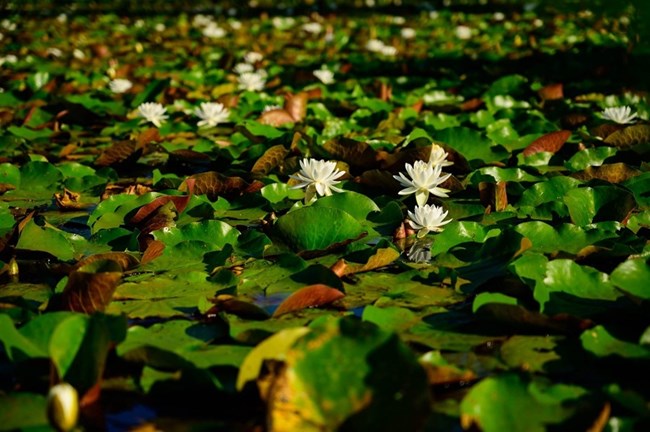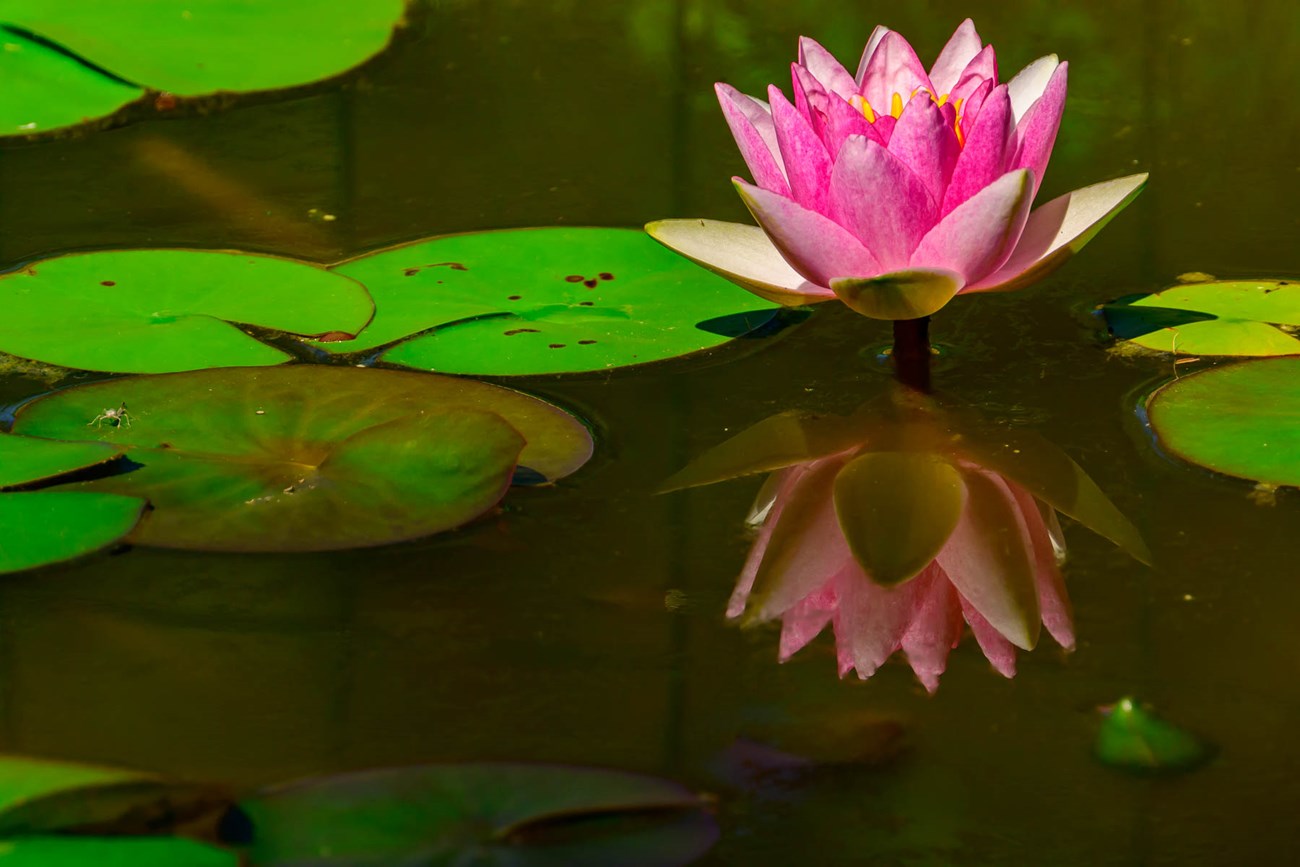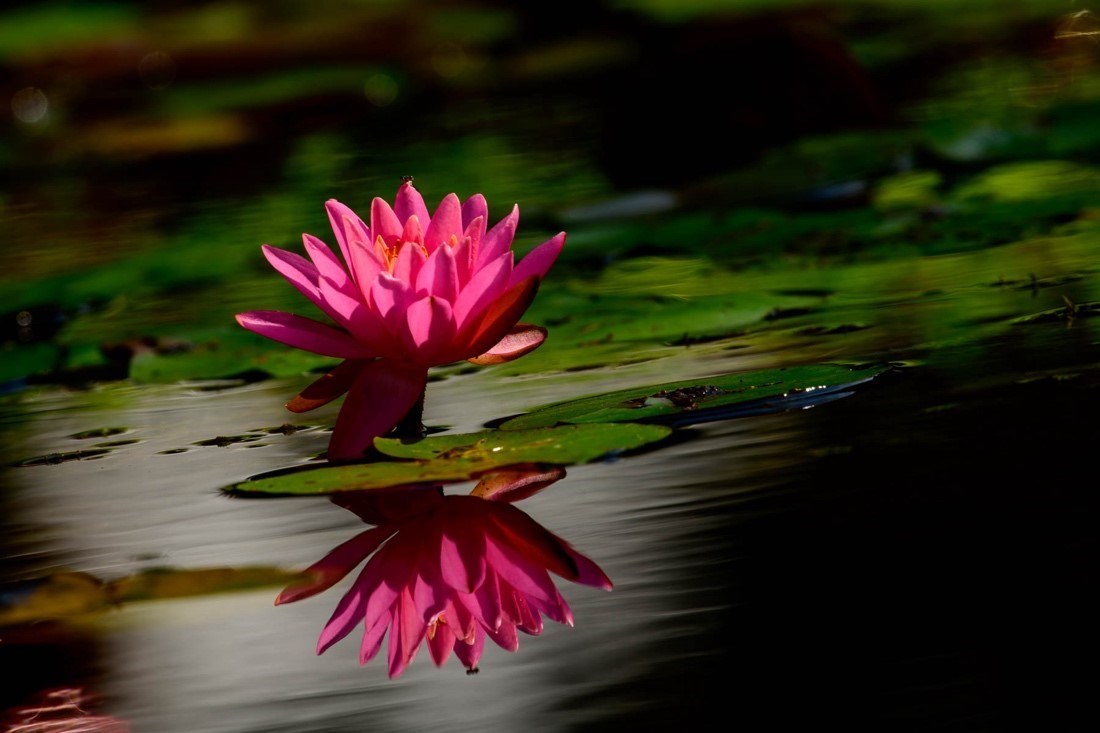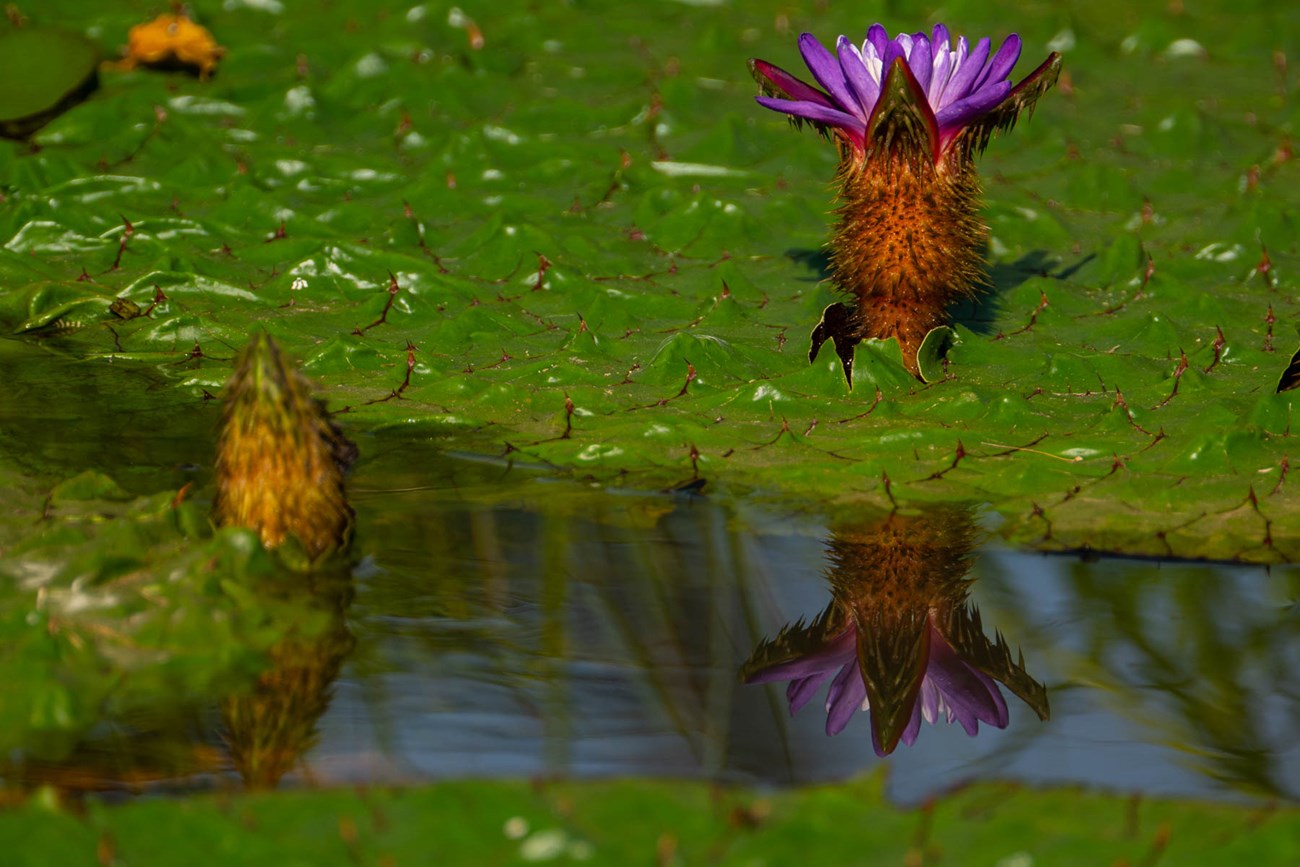
Tim Ervin Water lilies (Nymphaeaceae) are a family of freshwater flowering plants. Their scientific name comes from their ethereal beauty, reminiscent of a mythical water nymph. Water lilies are a charming garden plants because of their excellent beauty and the pleasure that they bring to our ponds. For hundreds of years, this beloved flower has been a source of spiritual significance. In Buddhism and Hinduism, water lilies are of particular importance. Waterlilies are symbolic of rebirth because the flowers close at night and come back in the morning. The waterlily is also seen as a sign of enlightenment by Buddhists because the flowers are rising out of the mud. There are 60 species of water lily, most of which have notched, round, waxy leaves on long stalks. The stalks are full of airy spaces, which allows the lily’s leaves to float. Waterlilies are available in both hardy and tropical types. Nearly all species of hardy waterlilies are perennial, meaning that they live for a year or longer. Tropical waterlilies will only survive year-round in tropical zones. Most tropical waterlilies bloom during the day, but there are a few nights blooming tropical waterlilies that are truly impressive.
Tim Ervin 
Tim Ervin Tropical water lilies cannot withstand freezing temperatures and must be overwintered in a hothouse or similar structure. Tropical waterlilies will go back to the bulb state when it's colder than 55 degrees, and the pot will be completely empty. The bulb returns to a carbohydrate state during the dormant winter months. This process helps the plant to retain energy, so that next spring it can regenerate itself. They will also produce small baby bulbs that can be placed in their own flowerpots the following spring during this dormant period. Compared to hardy variations, tropical water lilies typically have larger leaves, more blooms per plant, higher flowers, and round rhizomes. Physical differences are easy to notice. Although both Hardy and Tropical Water lilies are available in sizes ranging from dwarf to large, the hardy lilies tend to be much smaller than the tropical waterlilies. Hardy water lily flowers float on the surface of the water, while tropical water lilies have a long flower stalk that can reach up to 12 inches tall. The Tropical come in vibrant colors, including blues and purples and are showier than their hardy counterparts, which are typically yellow, white, and pink. The Tropical Lily's leaves are thin, scalloped, or irregular and can be green, maroon, or mottled, and the Hardy's round, thick, waxy leaves are usually green or slightly mottled. Hardy Water Lilies:
Tim Ervin Nymphaea odorata Nymphaea odorata, also known as the American white waterlily, is a fragrant white flower with a purple underside of the lily pads. These lilies are native to much of the United States. These were the first flowers planted by Walter Shaw on this property. He brought the flower from Maine, where he was originally from. 
Tim Ervin Nymphaea odorata subsp. Tuberosa These lilies are a subspecies of the American white waterlily. These white-water lilies have tuberosa stems that are striped and a green underside of lily pads. They can be differentiated from the American white waterlily by the color of the underside of their leaves as well as the shape and number of their flower petals. 
Tim Ervin Nymphaea Wanvisa A most unusual multipletaled deep pink-orange petaled flower that has streaks of yellow. Then, throughout the year, the flower may show a yellow solid coloration in the petals. The lily pads are large and often streaked with a deep red or purple. 
Tim Ervin Nymphaea ‘Marliacea Carnea’ This world famous French hardy water lily hybridizer known as M. Marliac's introduced this water lily in 1887 and is perhaps one of his greatest productions, known also as 'Marliac carnea'. Today, this water lily has become extremely popular. It has star-shaped blossoms, vanilla scented, soft, shell pink, deepening towards the base of the petals and paling gradually to white. Stamens are golden-yellow. As cut flowers, they have a fine lasting quality. Leaves are large, dark purplish red changing to deep green. Also, you can find the remnants of this water lily represented in the famous paintings by the French Claude Monet. (Found in ponds 
Tim Ervin Nymphaea ‘Pink Opal’ This 1915 American variety was developed by Helen Fowler. Pink Opal has many good qualities. Blossoms are cup shaped, very fragrant, of a coral-red color, and are held above the water's surface. Petals are numerous, short, and quite broad. Lily pads are bright green and float on the surface of the water. 
Tim Ervin Nymphaea ‘Rose Arey’ Helen Fowler, daughter of the famous water gardener and hybridizer W.B. Shaw of Shaw Gardens in Washington, D.C., produced this pink hybrid in 1913 and was given its name in honor of her cousin. The blossom is a uniform shade of rose-pink, star shaped, with an abundance of yellow stamens. Its fragrance is of sweet fruits. When young the leaves are entirely dark red. It received the Award of Merit at the Royal Horticulture Society. It is a strong dependable grower. 
Tim Ervin Malikan Malikan is a new Award Winning waterlily in the hardy waterlily category, and is profoundly beautiful in luscious shades of rich, deep-pink with a high petal count (average count is 200). This is a heavy bloomer that blooms more than most high petal count varieties! Malikan Waterlily was hybridized by Potjanee of Thailand. 
Tim Ervin Pin Waree is a new profusely blooming waterlily from Thailand. Medium to large heavy blooming yellow hardy waterlily. Its light-yellow blooms are star shaped with narrow petals. The flowers sit above the water. It is an aquatic perennial that performs best in full sun in loamy soil and undisturbed water. Their yellow color makes them unique for a hardy water lily. Tropical Water Lilies:
Tim Ervin Prickly Water Lily, or Gorgon Plant, is a perennial species of water lily. It is typically found in medium to large water gardens. It is easily propogated from seeds, but is nonviviparous (doesn’t germinate while attached to the parent plant). Euryale ferox has sharp spines on its stems and leaves and the leaves are dark green with purple veins. Individual leaves are 4 to 5 feet long and the plant itself will spread to a dramatic 15 ft flat pad on the water. The plant's flowers take the form of an inner row of white petals and an outer row of deep violet petals. It typically flowers during the day but note that the water garden requires a depth of 3 to 8 inches of water for best flower production. The plant prefers still water or, if grown in soil, a rich medium. However, it will not do well in the shade and is not cold hardy. 
Tim Ervin Victoria or giant waterlily is a genus of waterlilies, in the plant family Nymphaeaceae, with very large green leaves that lie flat on the water's surface. Victoria boliviana has a leaf that is up to 9.8 ft in width, on a stalk up to 26 ft in length. The genus name was given in honor of Queen Victoria of the United Kingdom. It pushes other water plants aside as it spreads out until only those of its kind remains. When this happens, it has nearly completely cut out the sunlight from getting to any plants below the water. All three species typically have four sepals each measuring 4.7 in long by 3.1 in wide. There are typically 50 to 70 petals and 150 to 200 stamens. 
Tim Ervin |
Last updated: March 7, 2024
